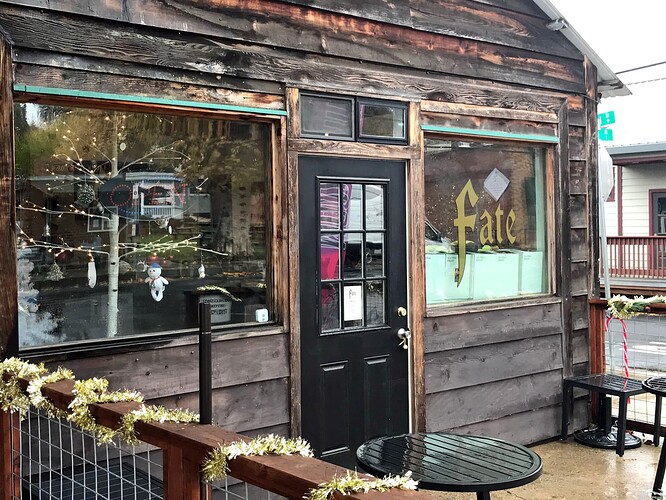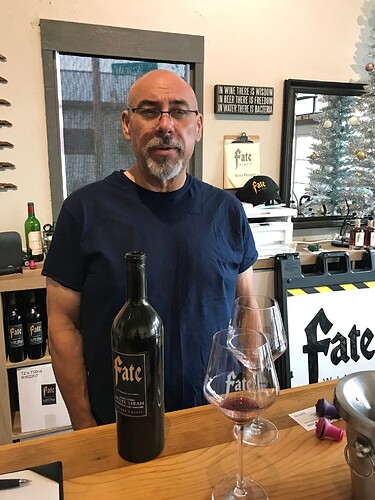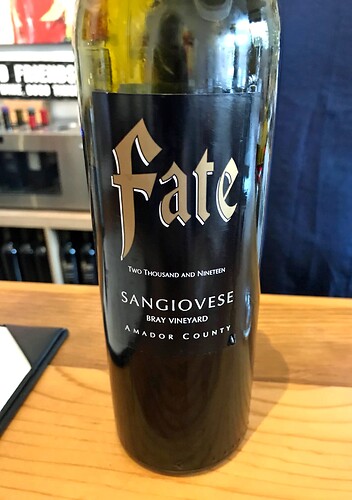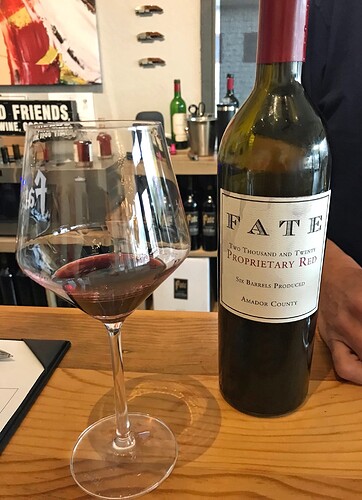Sierra Foothills Wine Visits, December 2022
I’ve posted a portion of a report on early-December wine visits to three wineries in the Sierra Foothills. The full version of this report is on the Grape-Nutz.com website:
Sierra Foothills Visits, December 2022
I haven’t been doing much Grape-Nutz wine touring lately, so this annual visit to the Sierra Foothills was only my second wine trip of the year. I’d checked with a handful of friends about coming along but after none of the ones I asked could join me I decided to just make it a solo trip this time. I headed out from Oakland on the first Saturday of December, and it was a smooth but wet drive to Sacramento and then east to the Sierra Foothills. There was rain throughout the day with only a few breaks, but it wasn’t as cold as I thought it might be.
I visited three wineries on this trip – Cedarville is a regular stop for me when I’m in the area, and I’ve been to The End of Nowhere just once, about four years ago. The one that was a first time visit for me was Fate Wines, located in the small Gold Rush-era town of Plymouth in Amador County.
Fate Wines
Cedarville Vineyard
The End of Nowhere
Fate Wines
The main street of Plymouth looked pretty quiet on the rainy morning when I arrived in front of the tasting room of Fate Wines. Owner / winemaker Thomas Allan was there to greet me at the front door and welcomed me inside. I’d heard good things about the Fate wines but had never tried any prior to my visit with Thomas. The tasting room opened in late summer 2021 – it’s a small, unpretentious space with a wooden bar, and it also has a nice outdoor seating area in front of the building. Thomas had poured his Fate wines at other places prior to opening his own tasting room, including at the Amador 360 Winery Collective in Plymouth that features wines from a number of small local producers. He started right in with pouring his first wine but since I was there before the regular tasting hours we had plenty of time to talk as I went through the Fate wine lineup, and he told me a bit about his background.
Thomas grew up in Santa Barbara County, and he started working as a waiter in local restaurants when he was 15. He told me that by the time he was 17 he was working at higher-end fine-dining restaurants in Santa Barbara, where he was introduced to wines from around the world. This started him on a path into the food and wine business that has taken many turns – he’s a certified sommelier, and has worked as a restaurant managing partner and in wine retail among other positions. He worked at Los Olivos Wine Merchant and at the renowned Wine Cask in Santa Barbara. Thomas told me that by his late 20s he wanted to work at wineries to learn that side of the business, and this included stints at Santa Barbara Winery, Alma Rosa, and Margerum in Santa Barbara County.
Eventually Thomas learned enough from his work at wineries to try his own hand at winemaking. Since he had a shoestring budget to do that, he decided that he needed a less-expensive location than in the increasingly upscale Santa Barbara County wine region. As some of his family live in Amador County, he decided to move there in 2010. While Thomas was learning about making wine and becoming familiar with the Amador wine scene, he also served as sommelier and wine director at Plymouth’s well-known Taste Restaurant, one of the finest dining establishments in the Sierra Foothills. He’s worked for Bray Vineyards and Story Winery in Shenandoah Valley, and he started making small lots of his own wine at those facilities, launching his Fate label shortly after he arrived in Amador County. Thomas left Story to focus on his Fate Wines label in 2021.
As I talked with Thomas, told me about his winemaking goals and methods. He noted that all of his wines are 14% alcohol or lower – this is unusual in Amador County, which has been known for riper, higher-alcohol wines over the years. Thomas’ background in the restaurant business led him to make his wines with the lower alcohol and higher acidity found in many European wines (though also in a growing number of California wines), as this generally helps wines go better with food. He told me an interesting anecdote that another sommelier at the Wine Cask had mentioned to him – he felt that European and American palates could be generalized by the notion that the European palate prefers mustard while the American palate favors ketchup – a sweeter and less subtle flavor. Thomas said that the finish of a wine is of particular importance to him, so managing tannins is a critical part of his winemaking regimen.
The Fate wines typically undergo concurrent primary and malolactic fermentation and are pressed as soon as they go dry, with no extended maceration. This allows them to be protected from brettanomyces and other issues as quickly as possible. Thomas ages all of his wines in neutral oak except for the “Proprietor’s Blend,” which has a small percentage of new oak during barrel-aging. Wines are racked and blended in March and bottled in June of the year after harvest, then aged for about two years in bottle prior to release. All of the Fate wines are blends of at least two grape varieties other than the Sangiovese, which is a blend of two distinct clones of the variety.
The current-release Fate wines (other than the “Elixir” dessert wine) were made at Story, and Thomas had made them at Bray before that – he’s now making his wine at the Helwig Winery facility in Shenandoah Valley. Annual production is around 800-1,000 cases, with the focus on fruit from Amador County vineyards. All of the current Fate wines are reds, except for the “Elixir.” Thomas usually makes about six different wines each vintage, so each one is a small lot, mostly 100-200 cases each though some are even smaller. He told me that his goal is to make about 1,500 cases per year.
Thomas started out my tasting of his Fate wines with the 2019 Bray Vineyard Sangiovese. He told me that Sangiovese is the third most-planted variety in Amador County, behind only Zinfandel and Barbera – something I didn’t realize and which surprised me. This wine is a blend of about 85% Sangiovetto Clone and 15% Brunello Clone Sangiovese. Displaying bright cherry fruit, earth, and spice, a medium-light texture with vibrant acidity and a zingy finish, this was a very fine start to the tasting. Next was the 2019 “Fusion,” which is a roughly equal blend of Sangiovese, Barbera and Primitivo. Thomas described it as being his “house red” style wine, and it featured more upfront fruit combining both black cherry and boysenberry notes – the acidity was a little toned down from that of the Sangiovese but still gave the wine a freshness on the palate with a long tasty finish.
The 2019 Bray Vineyard Tempranillo is blended with 13% Grenache, and Thomas explained that the goal of the Grenache component is to brighten up the wine and give it more upfront fruit. The variety’s characteristic earthy, leathery, and spicy plum and darker berry notes were indeed given an aromatic lift by the juicier red fruit of the Grenache, with medium-full body in the mouth and moderate tannins. I generally feel that California Tempranillo benefits from some blending and this was a nice one. Thomas next poured his 2020 “Double Barrel” Shenandoah Oaks Vineyard Petite Sirah, so named for the number of barrels of this wine produced in that vintage. With 10% Zinfandel blended in, it had a dark berry fruit profile with hints of earth, flowers, and spice, a bolder mouthfeel and grippy but not harsh tannins on the finish.
We finished up the red wines with the 2020 “Proprietary Red.” This is a blend of about 50% Petite Sirah along with 25% each Alicante Bouschet and Cabernet Sauvignon. Aged in about 15% new oak, Thomas considers this to be the flagship wine of the Fate label, and it features a more upscale label design. He noted that it aims to emulate a Bordeaux blend stylistically while using mostly non-Bordeaux grape varieties that are better-suited to the Amador growing region. With plum and darker fruit aromas plus earth, a touch of oak, and a pleasant smoky note, this had a lively, elegant texture and fine tannins.
The final wine that Thomas poured for me was the NV “Elixir” – this is a fortified blend of Viognier, Verdelho, and Black Muscat, with about 18% alcohol and 9% residual sugar. This featured aromas that included figs and stone fruit, pecans, and honey, with a medium-rich mouthfeel and a long, moderately sweet finish. This was quite unique, not like anything else I could recall tasting, with a more subtle and complex character than most California sweet wines. In addition to the wines I tasted with Thomas, Fate also has a Barbera that’s blended with a small percentage of Grenache.
I enjoyed my visit with Thomas and liked the Fate wines – they show a lighter, brighter, fresher side of Amador County wines. Even at the moderate alcohol levels of these wines, there’s plenty of fruit, plus more lively acidity that helps set them apart from many others in the region – more food-friendly than many of the bigger and riper Amador wines. All of the wines I tasted were very good, with favorites being the 2019 Sangiovese, 2019 Tempranillo, and NV “Elixir.” Thomas mentioned that it’s been a long journey to get where he is today and that it must have been “fate” that brought him here. The Fate Wines tasting room is a very nice addition to the town of Plymouth, and well worth a stop if you’re planning to visit the area.



